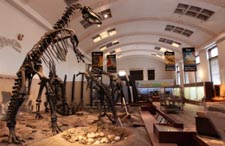Utah Museum of Natural History
situated on the campus of the University of Utah in
Salt Lake City, Utah, this museum showcases natural history subjects
and more specifically about the state's natural history. The museum
houses more than 1.2 million objects in its huge collection that is
used for education and research, emphasizing the natural history of
the state and making it accessible for the researchers of the world.
The vast majority of this outstanding collection is from public
lands that exist within the inter-mountain region of the nation and
are used in the studies of biological, geological and cultural
diversity, as well as living systems and human cultures in the Utah
region. In their anthropology collection there three-quarters of a
million objects in the archaeological collections, with the
associated records coming from over 3800 sites and over 2000 objects
from their ethnographic collections. In their spectacular biology
collection there are 30,000 specimens of animals, 180,000 insects,
20,000 birds, 22,000 mollusks, 18,000 lower vertebrates and 123,000
plant specimens in the Garrett Herbarium, that include many with
viable seeds and spores. The geology collection contains 3600
minerals, 4000 plant and 2500 invertebrate fossils, 250 rocks and
20,000 vertebrate fossils that includes the famous Cleveland-Lloyd
Jurassic dinosaur collections, significant lower Cretaceous
dinosaurs from the museum's Long Walk quarry, late Cretaceous
vertebrates from the Grand Staircase-Escalante National Monument and
other Cedar Mountain Formation localities.
|

